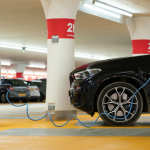Looking at the explosive growth of electric vehicle (EV) companies like Tesla and the projected expansion of EVs into the private and public sectors, they are poised to become the dominant mode of transportation.
While EVs will undoubtedly continue to become more commonplace in coming years, there are still some major barriers to their complete adoption. One of the largest and most problematic of these, at least in the United States, is the current lack of an EV charging infrastructure.
Fewer, More Densely-Packed EV Charging Stations Than Gas Stations
According to the U.S. Department of Energy,:
- 43,293 charging stations (U.S).
- Of these, fewer than 5,000 are fast charging stations – those that can provide a charge in an hour or less.
- Compared to:
- 136,000 gas stations across the U.S.
Most existing charging stations are in cities and areas with high population densities. There are huge gaps in the current map of charge points, leaving those in rural areas, particularly in the Midwest, with few options for recharging their EVs.
Fleets Suffer From Lack of Charging Options As Well
For those in the medium- and heavy-duty fleet industries, charging options are equally limited. There are few convenient options for drivers to recharge their vehicles while on the road. Most vehicles currently rely on recharging at fleet facilities, limiting the range they can travel.
So what should people know about making EV charging more widespread and accessible?
It’s not one-size-fits-all.
High Cost of Fast Charging Stations Remains an Issue
Despite current government hopes to build 500,000 public EV charging stations by 2030, some serious legwork needs to be done to achieve that goal.
- State and local governments will need to continue to invest in EV infrastructure,
- Additional charging stations in public locations is needed,
- Government needs to and partner with component manufacturers and destinations to make installation easier.
Currently, installing a level 2 charging station
- One that provides a full charge in anywhere from 3 to 6 hours – can cost between $3,000 and $13,000 depending on quality and installation conditions.
- A level 3 charging station, providing a full charge in 30 minutes to an hour, costs around $50,000.
These prices are substantial hurdles for the installation of public chargers. However, as the technology continues to advance and EVs become more prominent on roads, prices are expected to drop.
Europe Leads Push to Electrify Gas Stations, US Begins to Follow
Slowly but surely, some gas stations are adding EV chargers to their facilities. BP has plans to roll out 400 fast charging stations in the UK by the end of 2021 and Germany recently announced that it would require all of its approximately 14,000 gas stations to provide EV charging options.
Europe and the UK have already built over 250,000 charging points with plans to implement many more, meaning that EV infrastructure creation is certainly attainable.
In the US, East Coast gas chain Wawa has a number of stations equipped with Tesla EV charging stations, with other chains across the country slowly adding EV options as well.
EV Charging Infrastructure Remains Sparse, But For How Long?
While growth for EV charging infrastructure in the US remains slower than in Europe, both governments and companies are continuing to invest in its expansion. The industry presents a valuable opportunity for those willing to make the investment, and the eventual payoff could reshape the worldwide transportation network.
There remains a large gap between where we’re at now and where we need to be in order to accommodate a major switch to battery-electric vehicles, but as the cost of installing chargers falls and investment in infrastructure rises, that gap is slowly closing.






